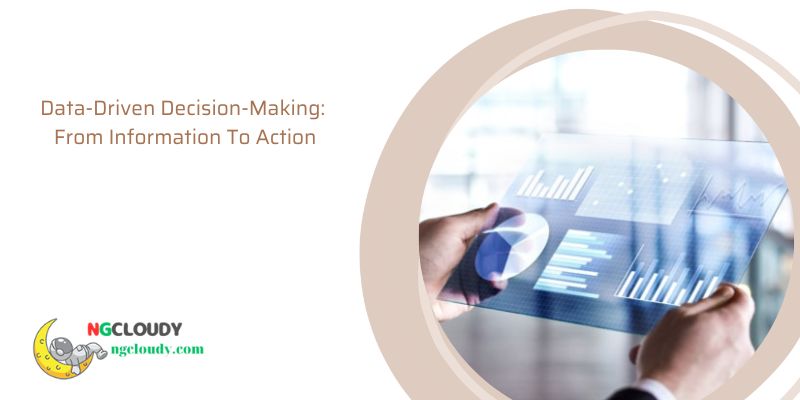Using accurate and data-driven decision-making and actions in a variety of fields, from business and healthcare to education and public policy, is known as data-driven decision-making. In today’s information-rich world, businesses and individuals have access to a tremendous amount of data that can offer insightful information and help them make better decisions. Individuals and organizations can choose more wisely, objectively, and effectively, which improves outcomes, by relying on data rather than presumptions or intuition. Find more on ngcloudy.com
What is decision-making based on data (DDDM)?

Making conclusions using solid facts, information, and data is known as “data-driven decision-making.” It is a strategy to decision-making that gathers, examines, and evaluates data pertaining to crucial KPIs and can serve as the cornerstone for all corporate choices. It makes sound business sense to include research in the procedure for validating any venture.
More data on modern consumers is being left online than ever before, giving businesses the opportunity to research anything from their interests and behavior to their purchasing habits and brand associations. With more thorough, trustworthy, and accurate data, organizations can make data-driven decisions more quickly than ever before, allowing them to pivot and flex at a rapid rate.
The advantages of data-driven decision-making

Organizations may detect trends, create new services or products, perform precise forecasting, and determine the best growth channels by making data-driven decisions. It may have an effect on practically every aspect of a firm, including clients, workers, hiring, income, and sales.
1. Increase ROI
Profitability of the company is directly impacted by data-driven decisions. It offers pertinent insights that can support boosting sales and reducing losses. A business may make decisions more clearly and confidently when they are supported by data rather than gut feeling or personal preferences.
2. Turn from being reactive to being proactive
Data offers insights that make it possible to see trends and patterns as well as make precise future predictions. You can analyze risks, make more informed planning decisions, and unearth possibilities that others might miss with the correct data.
You can be more proactive and take action before others do because of this. It’s similar to wearing night-vision goggles in the dark in that you can see things that others can’t, and you can then act and respond appropriately.
3. Boost client satisfaction
Customers that are happy with your service keep using it longer, tell others about it, and promote your company. You can increase customer satisfaction by using a data-driven decision-making approach in the following ways:
- Taking regular customer satisfaction surveys
- Getting suggestions
- Identifying trends
- Identifying the roots of apathy
- Taking action to combat discontent
- Enhancing services and processes to raise service standards
- It’s difficult to accurately understand how customers feel about your product without data. You are better able to meet and exceed client expectations when your decisions are supported by good facts.
4. Acquire a competitive edge
All successful businesses have one thing in common: they always stay one step ahead of their rivals. Knowing your market inside and out gives you leverage. You can keep a careful eye on the actions, promotions, and strategies of your competitors by using a data-driven decision-making method.
You are then in a better position to anticipate their moves and counteract their plans by acting more swiftly and intelligently.
Example of data-driven decision-making
This example illustrates how to do competitive research. Wonderbly, a multinational company with 6 million clients, shared it with us. It was possible to determine that the competitor was doing a better job of drawing a younger audience by studying the audience demographics of a significant rival and looking at gender and age distribution.
5. More self-assurance in judgment
Making judgments based on data reduces ambiguity, accentuates areas of clarity, and eliminates gray areas. Your choices don’t come from conjecture or wishful thinking. It results from making thoughtful decisions based on information gleaned from thorough data gathered throughout the customer life cycle.
Naturally, this implies that you are confident in your judgments, which filters down to your teams and empowers them to adhere to your directions with greater fervor.
Data-driven decision-making: How to make decisions in your business based on data

There is a method to follow and a mindset to change in order to create a culture of data-driven decision-making in your organization. Using data to make decisions has advantages for everyone, from the most seasoned corporate leaders to those who are just starting out in the workforce.
1. Establish precise objectives that correspond to business ones
Before spending money on data analytics or any other solution, you should first provide an answer to that question. For instance, you might want to streamline your procedures, check for weaknesses, and determine your best sales channels. Or perhaps you’re seeking for more audience insights to guide your product or marketing strategy.
2. Carry out market analysis
Consult your internal teams and decision-makers to learn about their present data sources, the questions they want data to address, and their future goals for those sources.
Research the market to discover how other businesses address these issues based on their comments. In order to meet the decision-making objectives of your firm, this would help you comprehend the data sources you need to enhance and the market research instruments necessary.
3. Compile and ready the data
You must first identify all of your current and potential data sources and create a consolidated data repository before you can analyze and understand data. If your decision-makers currently use data from unconnected sources, this may be difficult. There is a risk of inaccurate and duplicate data in particular.
In conclusion, data-driven decision-making is a formidable paradigm that enables people and organizations to harness the potential of data for intelligent and sensible decisions. Decision-makers obtain important insights that lead to better outcomes and improved strategies by methodically gathering, evaluating, and interpreting data. This strategy cuts across sectors and industries, providing a methodical manner to handle problems, spot openings, and raise overall decision-quality.

